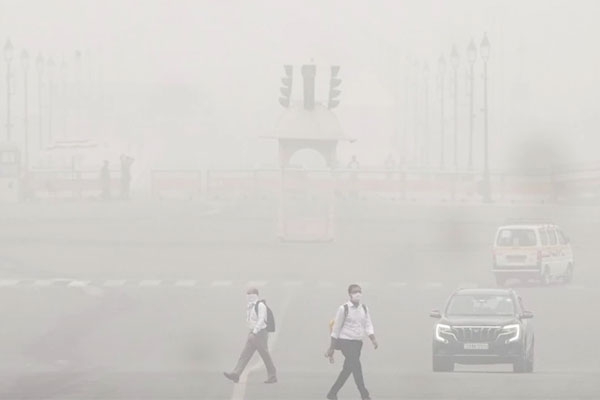
(Image source from: Indiatoday.in)
Delhi-NCR and several other parts of the country are witnessing an alarming rise in pollution. Currently, the Air Quality Index (AIX) in Delhi-NCR is in the range of 300-400 and crosses the 500 mark at times. Air pollution poses a serious health risk, especially in winter when vehicle exhaust, industrial pollutants and stubble burning combine. Generates high levels of smog. Experts say dangerous air quality is linked to reduced life expectancy, heart disease and respiratory problems. Children, older people and people with previous illnesses are particularly vulnerable to the long-term effects of this exposure, the researchers warned.
The World Heart Federation (WHF) World Heart Report 2024 reveals alarming statistics about the link between global air pollution and cardiovascular disease (CVD). In India, which is currently suffering from a CVD epidemic, the impact of environmental factors, particularly air pollution, has become a major public health challenge. According to the report, air pollution worsens all major cardiovascular diseases, including ischemic heart disease (IHD) and stroke, and collectively causes millions of deaths each year. Globally, air pollution was responsible for 22% of coronary heart disease deaths and 15% of stroke deaths in 2019. The situation is even more critical in India, where urbanization and industrialization continue to advance. Dense air pollution across the country, compounded by agricultural waste burning in Punjab and Haryana, contributes to the burden of heart disease.
Experts are now calling for immediate attention and action to combat these environmental triggers of cardiovascular disease. Cardiologists and public health experts in India emphasize that combating cardiovascular health problems will continue to be an uphill battle if environmental pollution is not addressed. Long-term exposure to air pollution leads to endothelial dysfunction and oxidative stress, both of which are important precursors of cardiovascular disease. In India, the incidence of diseases such as coronary heart disease, stroke and heart failure has increased significantly in polluted areas. These pollutants not only increase blood pressure, but also trigger an inflammatory reaction in the blood vessels, promote arteriosclerosis and further increase the risk of heart attack and stroke. The Global Heart report also found that particulate matter from agricultural activities, particularly residue burning in northern India, has a major impact on air quality. The piles created by burning logs contribute to an increase in particulate matter (PM2.5 and PM10), which worsens the cardiovascular health of millions of people.
Environmental pollution has serious impacts on human health. It can worsen respiratory diseases such as COPD and asthma. Increased risk of heart disease. It is also a major risk factor for stroke, cognitive impairment and dementia. Pollution negatively impacts mental health, leading to difficulty concentrating, irritability and brain fog. There is growing evidence that exposure to air pollution increases the risk of cognitive decline and neurological diseases such as Alzheimer's and Parkinson's. Poor air quality has a major impact on our mental health and increases the risk of anxiety and depression.
The main causes of this increased risk include increased nitrogen dioxide levels resulting from greenhouse gas emissions, residential wood burning, industrial greenhouse gas emissions, gardening equipment, power plants, construction and emissions. But that doesn't mean we have to give up and accept air pollution as part of everyday life. We work to reduce air pollution in our communities by using public transportation whenever possible, reducing the use of wood and coal in our homes, maintaining our cars regularly, and replacing our tires regularly. You can also prevent exposure to high levels of air pollution by limiting your time in areas with high traffic and other pollutants and using filtration systems to keep the air in your home clean.
In addition to outdoor air pollution, indoor air pollution remains a significant problem in India, where millions of households rely on biomass for cooking. This form of pollution is associated with increased mortality from ischemic heart disease and stroke, making women and children in rural areas particularly vulnerable. The health impacts of air pollution are particularly evident among women and children in rural areas, as household air pollution is caused by cooking with biomass. Studies have shown that long-term exposure increases the incidence of high blood pressure, a major risk factor for heart disease. We must accelerate the transition to cleaner cooking alternatives and ensure public health interventions target this vulnerable population. Diabetes and obesity are also common in India and are major risk factors for cardiovascular disease. This suggests that air pollution worsens glucose processing, increases insulin resistance, and increases the risk of diabetes-related heart disease.
Patients who already suffer from comorbidities such as diabetes and obesity are doubly affected by air pollution. Air pollution worsens metabolic syndrome and increases the incidence of cardiovascular events. We observed an increase in diabetics with heart failure and ischemic heart disease, particularly during periods of high air pollution. There is an urgent need to raise awareness of the connection between air pollution and cardiovascular health. Given the current situation, we strongly advocate for stronger environmental policies at local and national levels. Experts urged policymakers, health experts and the general public to address the environmental factors that cause cardiovascular diseases in India. Without immediate and sustained action, air pollution will become a silent but deadly cause and the burden of heart disease will continue to increase.









